Storytelling in the Primary Classroom
Dr. Jyoti is a professor at Delhi University.

Fiza Gauri
Fiza Gauri is a passionate educator, blog writer, and a reader and aims to inspire young minds through creative storytelling and informative content. Her teaching expertise is in English and Science.
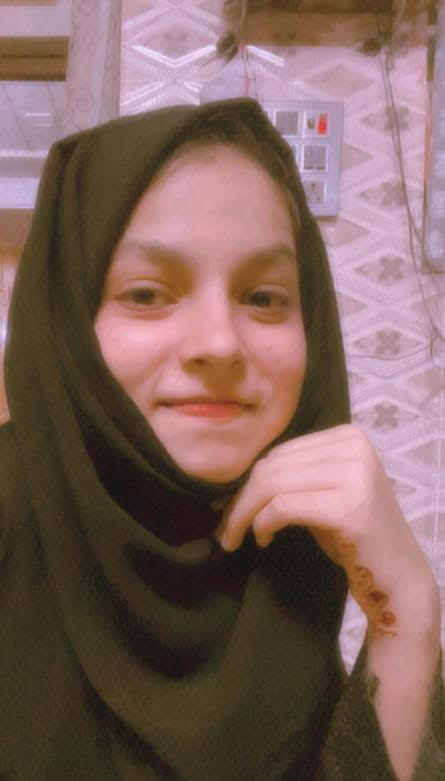
Zarqa Shafi
Zarqa Shafi observes, experiments, and tries to create engaging lessons that make learning fun. Her areas of interest are Mathematics and Science: igniting young minds, one lesson at a time.
In this article the authors share their insights on using self-authored picture story-books as a pedagogical tool for classroom engagement. These are based on their school internship experiences of teaching in the primary grades at a government primary school in New Delhi.
The National Policy of Education (NEP) 2020 recommends basing teaching of languages on an experiential-learning pedagogy ‘by weaving in the cultural aspects of the languages’ (GoI, 2020:15) through modes such as storytelling. As a follow-up to NEP 2020, GoI has launched a flagship programme titled as NIPUN Bharat or National Initiative for Proficiency in Reading with Understanding and Numeracy in 2021 for children of age group 3 to 9 years. This programme is in alignment with the visible emphasis in NEP 2020 on foundational literacy and numeracy in early grades. A key focus of NIPUN Bharat programme is on equipping teachers and empowering schools for planning engaging lessons through a variety of teaching learning materials. The marginal improvement in foundational learning outcomes particularly in grade III in the government school system as reported by the latest Annual Status of Education Report (ASER, 2024) has been attributed by some commentators to NIPUN Bharat (Dhawan and Sharma-Kukreja, 2025). Teachers who trained under this programme have highlighted the value of creating engagement in the classroom through storytelling-based approaches (ibid).
We used such an approach in our school internship as part of our pre-service teacher education which brought home to us the value of such an approach for engaging young students in the primary classroom. While storytelling and storytelling-based approaches are intrinsically worthwhile on a variety of counts; this article focuses on their utility as a pedagogical tool in school education. The authors’ teaching experience of how teacher-made story books were used as a tool of engaging primary grade students in the classroom are presented in this article with reference to the broader context of teaching, learning and language development.
Storytelling in primary grades
Educators have recognized the vital role of storytelling in the all-round growth and development of students especially in the foundational stage of life. Some have even gone as far as to suggest that ‘storytelling has a magical effect on children’ (Kumar, 2009: 70) and in grade I and II there should be a dedicated period in the school timetable every day for it (ibid). It contributes to young students’ intellectual, emotional and social growth providing cultural enrichment as well as humanizing experiences.
Storytelling and reading storybooks fosters language development, cognitive growth, emotional intelligence, and creativity, all of which are factors that support the all-round balanced growth of young children. Teachers thus often incorporate storybooks into their language education programmes at the primary level, with the belief that they provide children with a strong foundation for lifelong learning as well as language development, among other benefits. Introducing story-books to young children in the classroom provides a forum for discussing not just the storylines but also social issues, learning about religious and cultural diversity, while promoting cross-cultural understanding, empathy and respect for those who are different from us. It also helps children develop essential social skills, such as communication, cooperation and conflict resolution especially when the stories are read aloud and discussed in the classroom. Children get an opportunity for responding to the storylines, varied characters and other situations and discussing them in the group setting of a classroom. Research has established that reading stories aloud to children enhances language skills, comprehension and emotional development (Trelease, 2013).
Picture based storybooks for young children
Picture books have a unique role to play in literacy and language development at the foundational stage of education for young children. They can introduce simple new words and phrases, help children expand their vocabulary, explain simple sentence structures and provide an experience of the flow of language. Children also learn pronunciation as listening to stories often involves repeated phrases and dialogue, promoting appropriate pronunciation of words (Aukerman, 2007).
Why teacher-made story-books?
As prospective teachers, we recognise that teaching-learning occurs in a specific context. Education is locale-specific which necessitates the use of specific teacher-made teaching-learning materials in classrooms. These need to be developed keeping the social backgrounds, language known and cultural sensibility of children in a particular classroom context in view. National level initiatives like NIPUN Bharat sometimes tend to be designed keeping a general, homogenising perspective. In contrast, in our teaching internship, we wanted to use story-books particularly relevant to our students. We also wanted to use story-books beyond the ones that were present in the school library but the ones that we made keeping the unique sensitivities of the children we teach in our mind especially targeting young readers in grades I and II even though we did use these books in later primary grades as well. We authored hand-made story-books and planned to use them in a regular reading schedule in our classrooms. The process was a learning experience for us as we had to author a story that children would like and tell it in the classroom. We also prepared teaching plans to engage children in conversations based upon the storyline, its characters, pictures, illustration, scope for humour and other wider themes. We aimed to design picture books that were developmentally appropriate with minimal text, encouraging children to think and predict the story through the illustrations. We improved our creativity, drawing skills and gained insight into authoring the kind of books that children love to read. The colorful and bright big pictures were the nub of our story-books.
One of us authored a picture story-book, titled Alex and the Ogre, a story about a man who craved fame. One day, while he was sleeping outside his hut, a terrifying monster, the Ogre, appeared and tried to eat him. But instead of panicking, the man cleverly managed to bring the Ogre inside his house, by tricking him into his hut with an invitation to eat up his wife and children first, who were sleeping inside, so that they aren’t left alone in this world. As Ogre entered the hut Alex locked him up. In the meanwhile the rest of the villagers gathered around the hut. The Ogre became scared and fled. The villagers were impressed by the man’s ingenuity and praised him, making him famous overnight. However, ironically, he soon grew tired of all the attention and no longer wanted to be famous. He comes to realise the hollowness of his quest for fame as happiness comes only from within. The story’s simplicity, combined with its vibrant illustrations and compact size, made it popular among children across various age groups, from second to fifth grades. When we shared this picture book with the grade II students, and narrated the story; their reactions were overwhelming. They were delighted to see the colorful illustrations and eagerly asked questions about its creative process of preparation. Their comments reflected an aesthetic delight as is evident in their exclamations reproduced below:
“Ma’am, ye aapne banayi Hai?”
“Ma’am, aapne ye kese banayi hai?”
“Ma’am, aapne konsi sheets use kari hai?”
“Ma’am, ye pictures to bohot sundar hai!”
“Ma’am, mai bhi apni ek story book banaunga!”
“Ma’am, aapne pages ko jodha kese?”
“Isme jab rakshas window tod kar bhaga vo kitna funny tha”
“Famous hone se to Kuch Bhi nahi Hota”
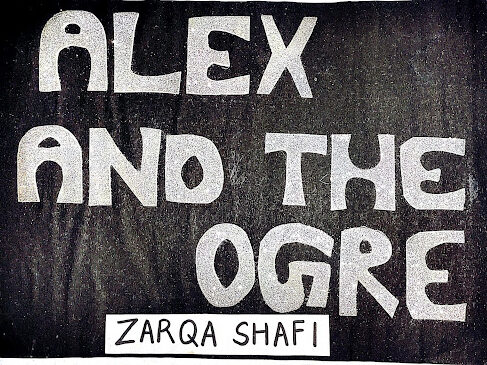
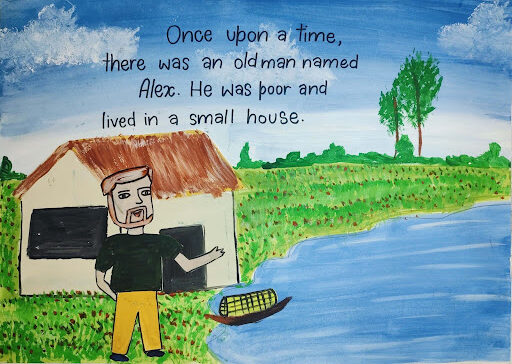


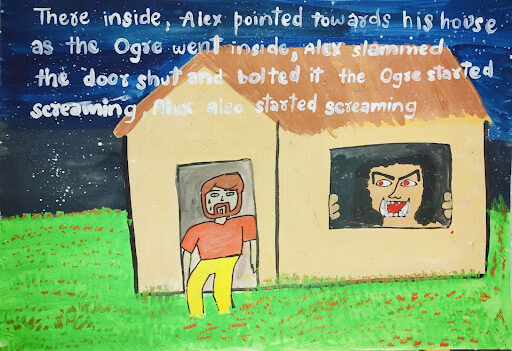
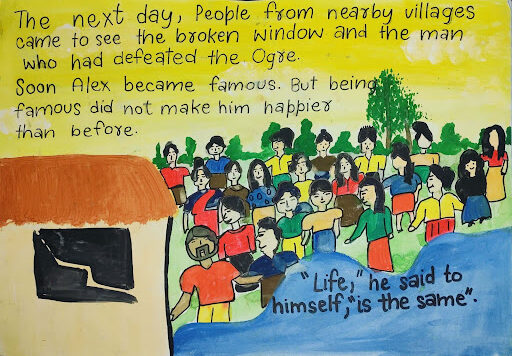
Alex and the Ogre, author and illustrator Zarqa Shafi
Among the reasons for children’s fascination with this story could perhaps be that ‘the desire for ideal types as well as the fear of catastrophe is a part of the psychology of childhood’ (Kumar, 2009:76). In Alex children identify one of the ideal persons they hope to become or meet in their life and in the situation of the monster Ogre threatening their very survival they experienced fear albeit vicariously. The universal themes of wisdom, fear, courage and bravery underlying Alex and the Ogre are perhaps among the reasons for the story’s appeal to our students’. A similar parallel can be drawn with the realistic portrayal of independence in Jan Brett’s popular story Annie and the Wild Animals which we found similar in its storytelling approach. The story follows a child living independently in a cabin in the woods, befriending wild animals along the way. The author presents a relatable and credible portrayal of independence, resonating with young readers. Realistic illustrations and subtle hints in the picture borders add depth to the narrative. By depicting Annie as a capable and resourceful young girl, the story shows achievable and empowering independence, tapping into children’s natural desire for autonomy and self-sufficiency.
Another story-book that one of us authored and illustrated, A Minute, featured handmade manipulable illustrations. It tells a riveting tale of a wealthy yet greedy man who constantly yearns for more money without having to work for it. He prayed for money from God and thought he was clever in his request, but God outwitted him, rejecting his artifice in his own way. God agreed to give the man a penny (a million dollars according to the man), but in a minute, which was equal to a million years according to God. It conveys the message that whatever goes around comes around. That prosperity can only come from patience, perseverance and hardwork. This story-book not only contains big and colourful illustrations but also moving objects (through handmade stringed-contraptions) where the students’ can move the objects according to the storyline adding an element of dynamic composition. Basic art and craft skills were used in producing the picture book. The idea of moving images turned out to be very enchanting for the students. Their responses were:
“Ye insaan to chal raha hai aur gadi bhi chal rahi hai, kitna maza aa raha hai baar baar chalane mein“
“Ma’am, aapne ye move kaise karaya?”
“Ye move kesee kar rahi hai?” (shocked to see)
“Isme subah se kahani shuru hui to end mei raat ho gayi”
“Ye uncle itne paison ka kya karenge”
“Mein hota to vese hi kama leta jaise iss insaan ne phele kamaye the”
“Acha Hua God ne mana kar diya, jo Hai uncle vo use nahi kar Rahe to aur Paison ka Kya Karenga?”
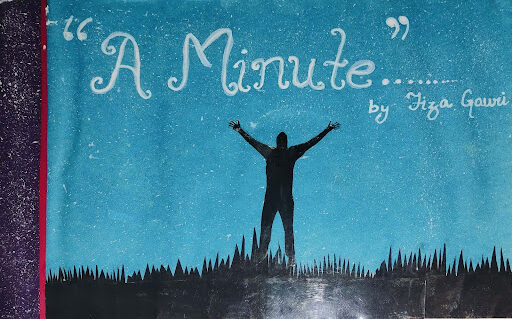
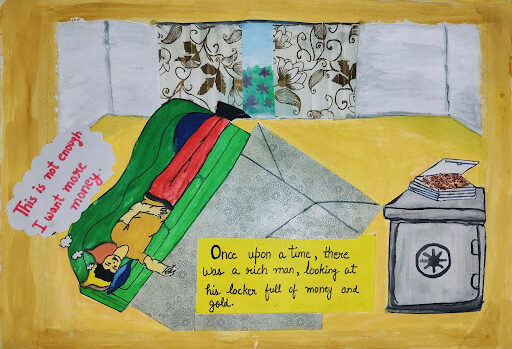
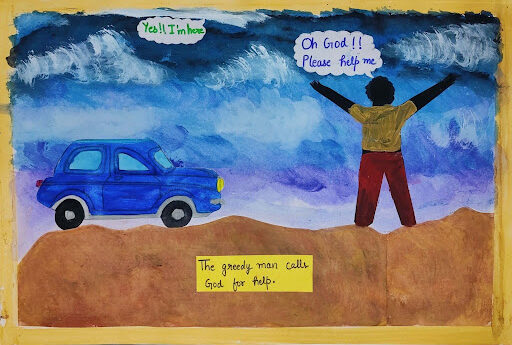

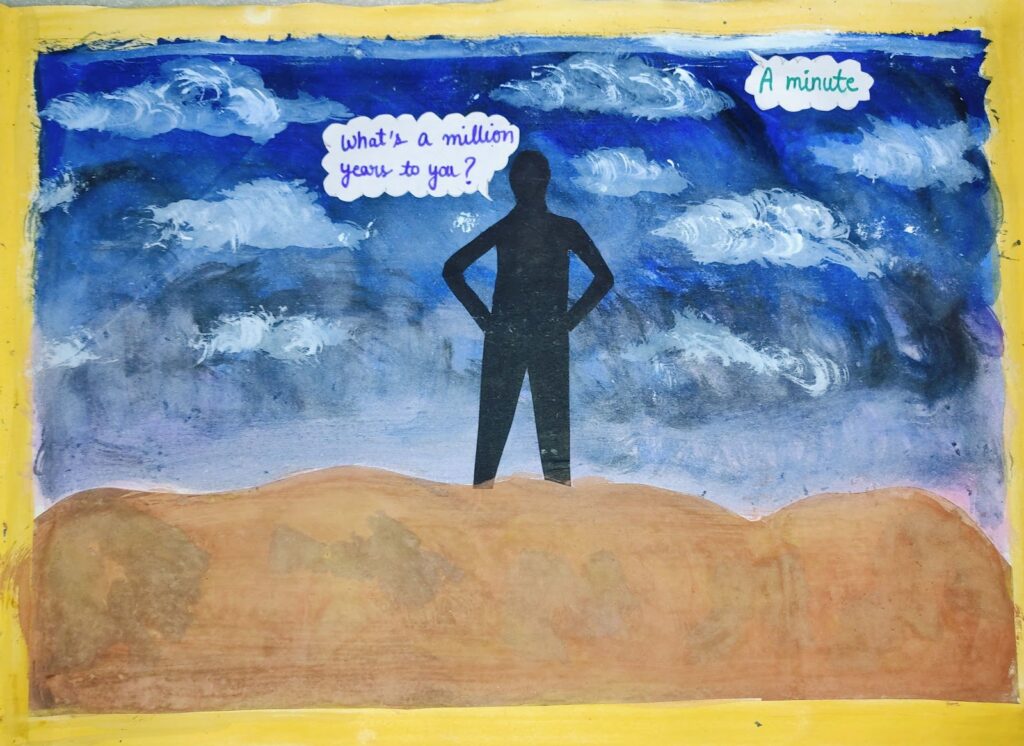
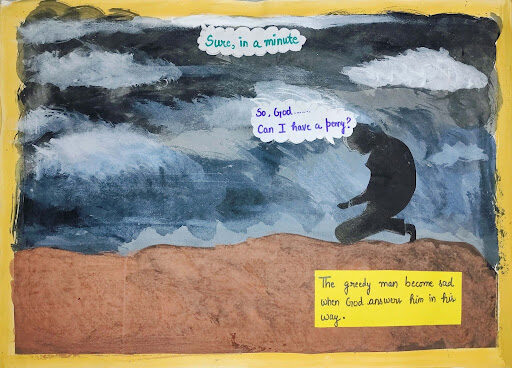
A Minute, author and illustrator Fiza Gauri
Picture credit: Fiza Gauri
Visual art has been considered significant in the early reading experiences. Visually illustrative story-books can talk to children and engage them in learning, creating their own space of knowledge and gaining an intelligent understanding of the world (Literature for Children, 1985). The making of A Minute offered a possibility to integrate skills such as art, craft and aesthetics in the way the pictures were drawn and visuals enriched with tactile manipulatives. The illustrations added meaning to the text aiding the narrative and enhancing a visual engagement due to the bright colors. In the classroom the storytelling experience was almost as if the colors brought emotions with them and enlivened the character of the wealthy man.
Fostering imagination and encouraging writing
The two story- books offered a near-magical experience to the young students’ in the classroom. The students’ insisted on knowing the details of how we made them so that they could also try making one. Exploiting this interest we planned an activity with the teaching objective of encouraging students to create their own story-books and picture-books. The relatively older students from third to fifth standard came up with amusing plotlines, showcasing their imagination, use of figurative language and storytelling abilities and even tried their hands at turning their story-books into illustrated picture books on simple sheets of paper. They wrote stories related to their own lives as well as of those around them adding some imagined elements. This activity invoked curiosity, self-expression, creativity, hands-on learning and enhanced their fine motor skills. The way students’ illustrated their stories was splendid, with a focus on simple details. The interesting titles for their story-books included:
“Ek raat ki mombatti”
“Foota Ghada”
“The mysterious Island”
“ Forest and Zoo”
“Ladkad”
It was enriching for us to note that almost all the young students were able to come up with some or the other story. With the younger first grade students, we conducted a classroom activity where they collectively, with scaffolds from the teacher, created a horror story about two friends and a haunted house. One by one, they added to the story, and then created illustrations. We compiled their work into a single story-book. The first grade students responses to this engagement include:
“Ma’am, us bhootni ki saree to pink thi isne red banadi!”
“Ma’am, iska pinku aisa hai mera aisa!”
“Ma’am, puri book banake hume dikhana”
“Ma’am, mera andhere vala room to chota hai, iska bada pinku kase ayega isme?”
“Ma’am, andhere wala kamra kese banau?”
All the students of first grade suggested many names for their collective class story-book and titled it Tinkus’s Evening after combining all the pictures made by them.
Fringe benefits
Storytelling is not just a pedagogical tool to engage students but presenting stories in interactive ways can be truly transformative, where the child immerses into the world of its imagination and extends her/his emotional horizons. The interactive storytelling approach we used not only captured the attention of the lower as well as upper primary grade children but also prompted them to take ownership of their learning, where they can write what they want, not what they are told to write. One of the most remarkable outcomes of this was the students’ desire to create their own story individually or in groups. They were eager to express themselves freely, writing about topics that genuinely interested them, rather than just following a predetermined school curriculum. This experience demonstrated the profound impact that interactive storytelling can engender in not only motivating students but can also help in enhancing their creativity, independent thinking and imagination. By providing students with the opportunity to engage with teacher-made illustrated stories in a hands-on approach, we can unlock their full potential, enrich them emotionally and foster a lifelong passion for learning. It encouraged them to listen carefully, participate in the discussion based on the story plot, characters and situations, raise questions, comment on characters and make inferences about life. The benefits of such pedagogical interventions are beyond this kind of informative experience. Students’ also observe the visual elements enhancing their creativity and observation skills. When the stories are narrated to children, it stimulates their imagination, creativity, and critical thinking. Story-books also foster a love for reading, which is a key element of lifelong learning offering a window into diverse cultures, traditions, and experiences. They help children develop an appreciation for the world’s richness and complexity, promoting cross-cultural understanding and empathy. Literature on story-books emphasizes their ability to engage young readers by appreciating characters in the stories including those in large sized picture books and other story-books just like our students’ experiential engagement with Alex.
We did not need the curated national level systematically planned teaching-learning resources such as those prepared under the NIPUN Bharat programme for facilitating such student-engagement in lower primary grades. The simple act of a teacher: introducing a self-made, illustrated story-book and using it in the classroom, in various ways sufficed for fostering active student-engagement.
References
- Aukerman, M. (2007). Telling stories: Using picture books as a tool for teaching language and literacy. The Reading Teacher, 61 (7), 532-541. https://doi.org/10.1598/RT.61.7.4
- Dhawan, A., & Sharma-Kukraja, S. (2025). A new classroom. The Indian Express. 1 February, 2025
- Government of India (2020) National Education Policy, 2020, GoI.
- Kumar, K. (2009). Storytelling: What is the use? In What is worth teaching? (pp. 100-115). Orient Blackswan.
- Literature for Children. (1985). The Reading Teacher, 39 (2), 224-229. https://www.jstor.org/stable/20199048
- Pratham. (2024). Annual Status of Education Report (ASER).
- Trelease, J. (2013). The read-aloud handbook (7th ed.). Penguin Books.
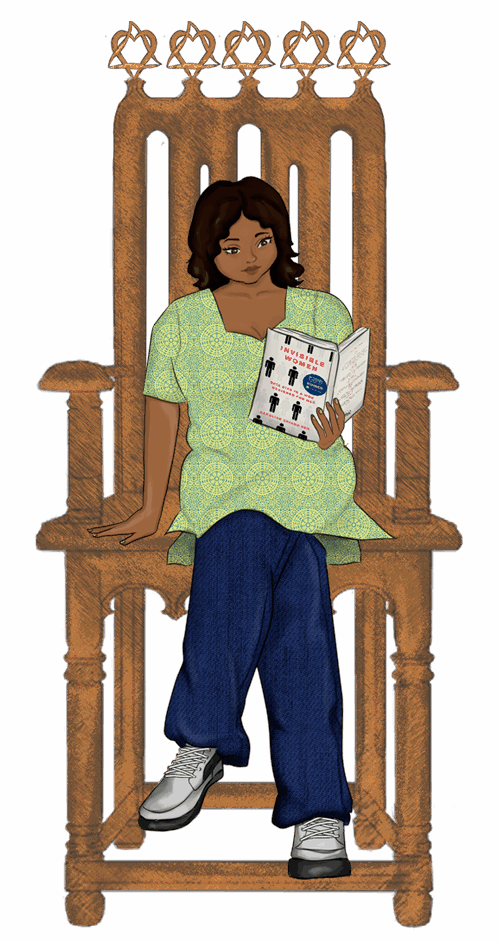
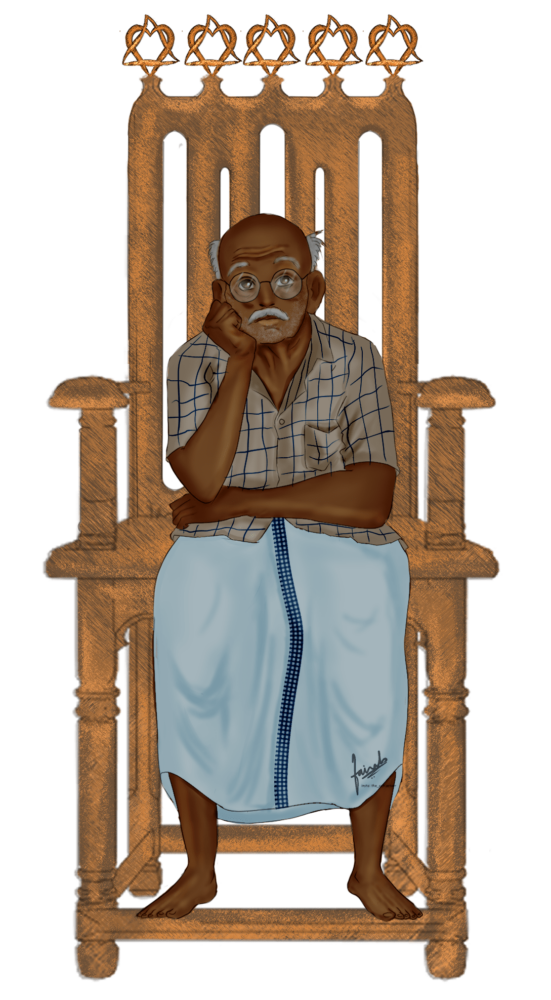


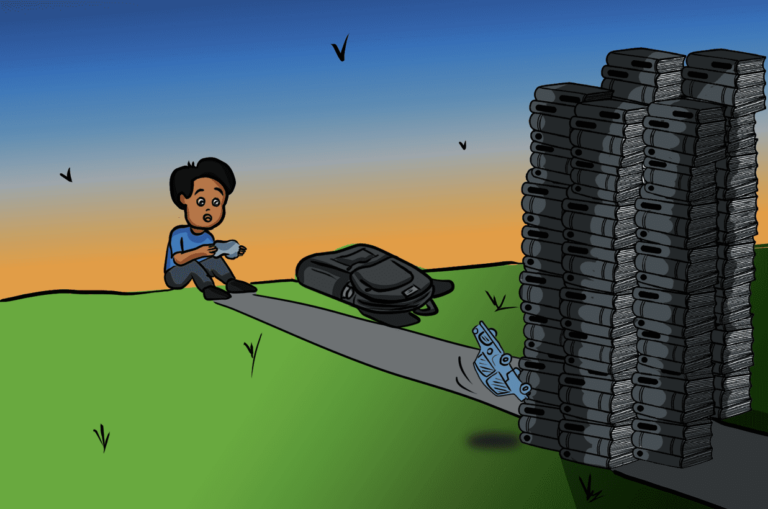
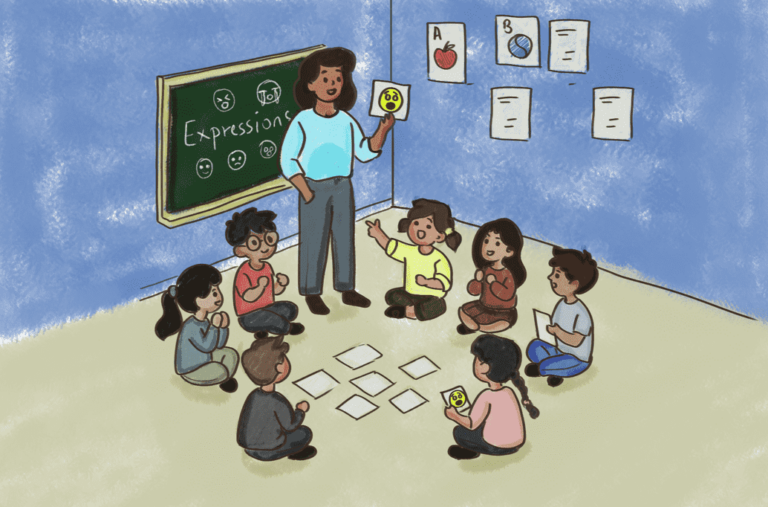
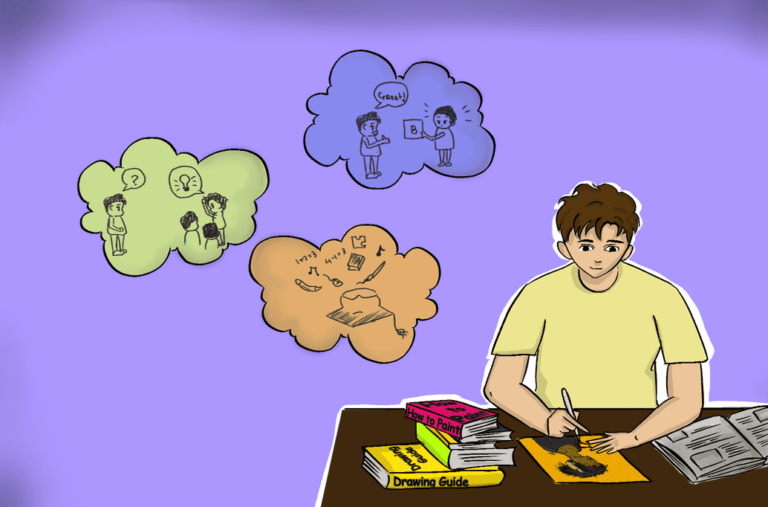
This article is an inspiring testament to how storytelling can truly transform primary classrooms into spaces of creativity, imagination, and active learning. The use of self-authored picture books not only makes the learning experience more relatable and context-specific but also encourages student expression and independent thinking
Reading this article truly resonated with me as someone learning to become a teacher. The idea of using self-made picture books to connect with students at a deeper level is not only creative but also incredibly meaningful. It beautifully shows how learning can go beyond textbooks when teachers use storytelling to reflect children’s own contexts and imaginationS
Very insightful and well written article
What my observation about this from the article and my experiences with children was they were never intrested in the so call expected moral of the story which every school story book asks for in fact their center of attention was the story, reliability with characters, a sense of connection with the story, the material used to make the book, often these things are considered as a waste of time or useless in classroom while this is a sign of child exploring the book and engaging with it
Storybooks are the most important part of TLMs and reading this article I know why
Thankyou
It is a warm and insightful reflection on the power of storytelling in primary classrooms. Based on their school internship experiences, it beautifully captures how simple, self-made picture storybooks can spark curiosity, build language skills, and create joyful, meaningful learning moments for young children. As a teacher of nursery children I can totally relate and say that it’s heartening to see how their work ties into larger goals like NEP 2020 and NIPUN Bharat while keeping the child at the centre of it all and how strong a tool of story telling is.
This article beautifully captures the magic of storytelling in primary classrooms. By using self-created picture books, teachers not only make lessons more engaging but also foster creativity, empathy, and stronger literacy skills among young learners. It’s inspiring to see how such simple yet thoughtful methods can align with larger educational goals like NEP 2020 and truly enrich the learning experience.
The essence of storytelling which is definitely a marvellous art which both the authors beautifully shown. Also, I could remember about the shared storybook which can be made in collaboration with student and teachers, also it gives a sense of ownership and attachment with the shared storybook they made together. Hardly any student doesn’t engage with storytelling sessions – big books encourage them to anticipate and predict the text. Bringing love for reading, which is the essential part of learning language help students to explore more about the text.
During my 3rd year block teaching session, I along with my classmate used storybooks brought by the initiative of NIPUN Bharat, and found students are extremely happy toh go through these story books, but sadly they are put in closed boxes and teacher don’t have time and motivation to explore other than text bcoz of never ending office works. This issue should be addressed which will lead to great impact of building love for reading and writing through storybooks.